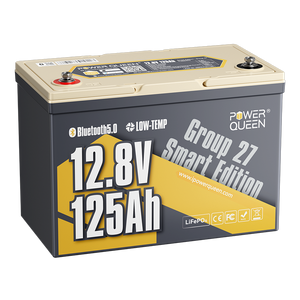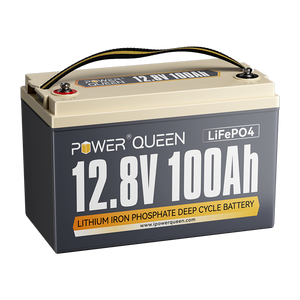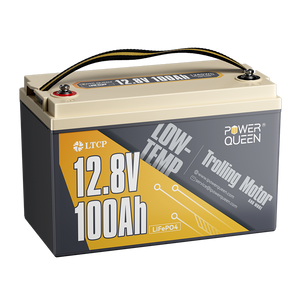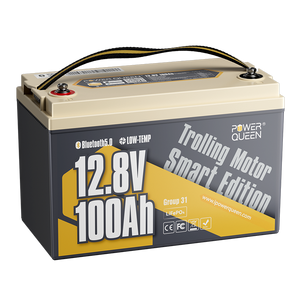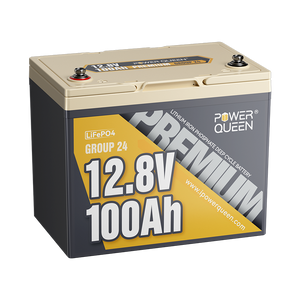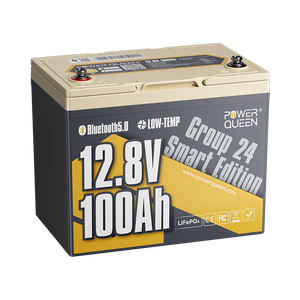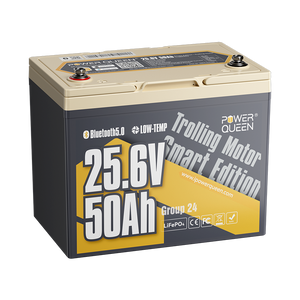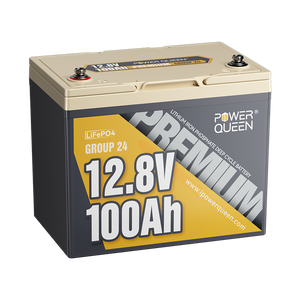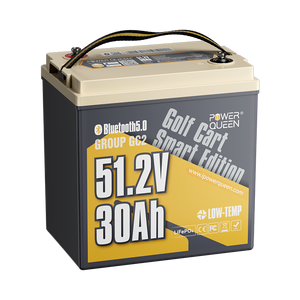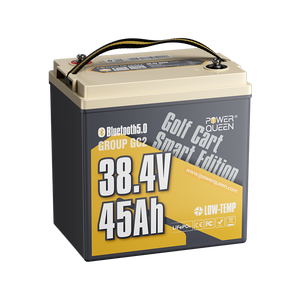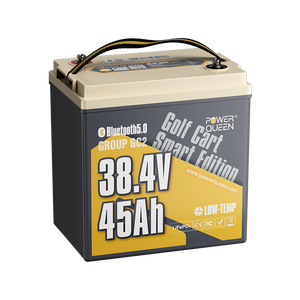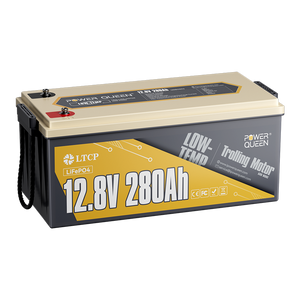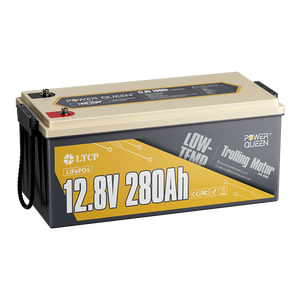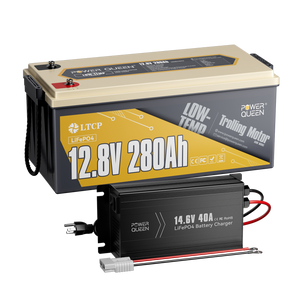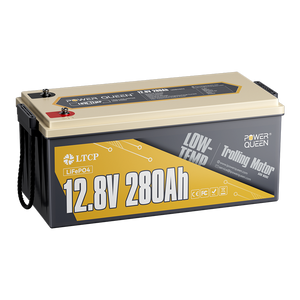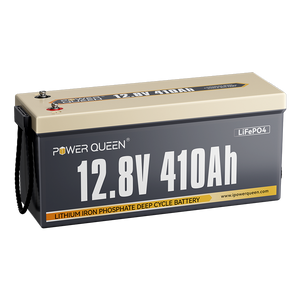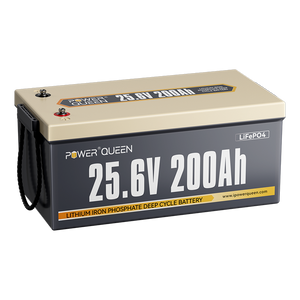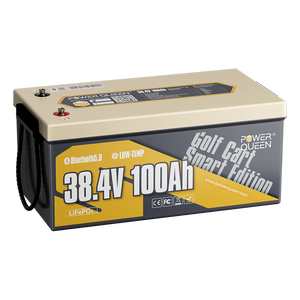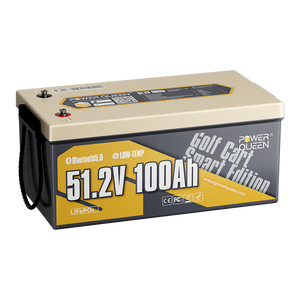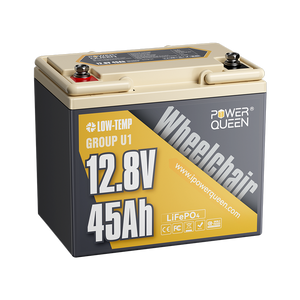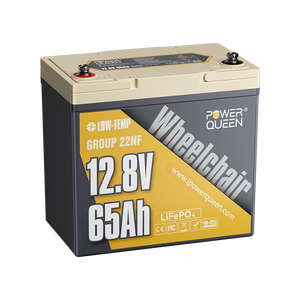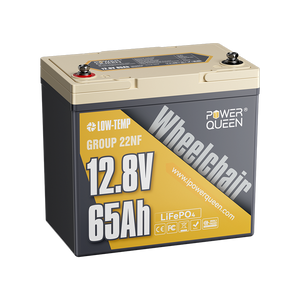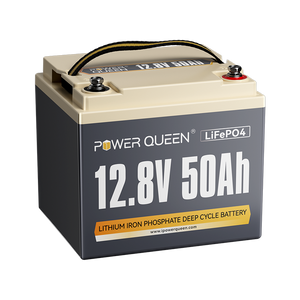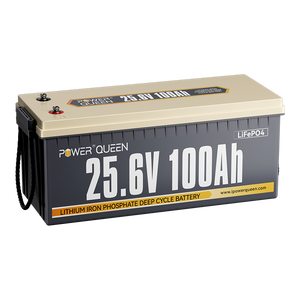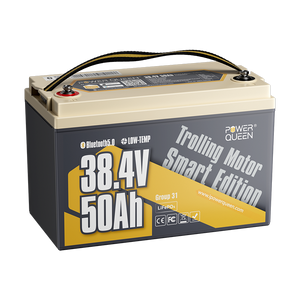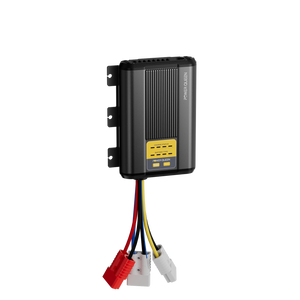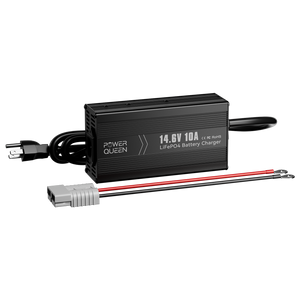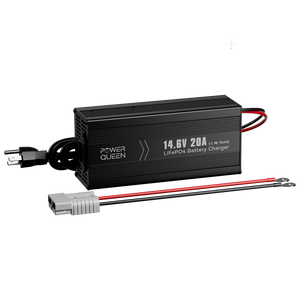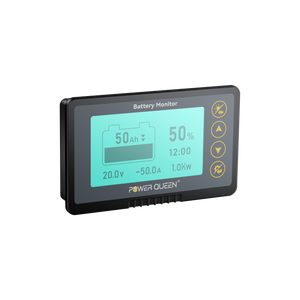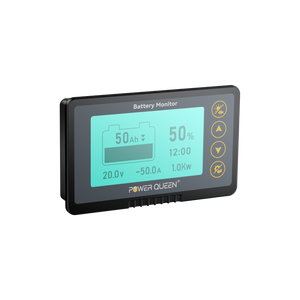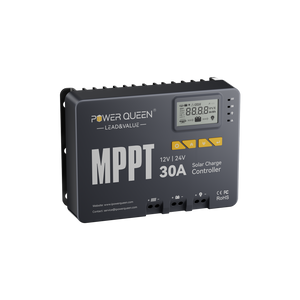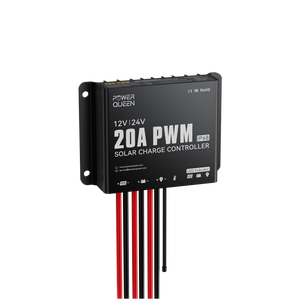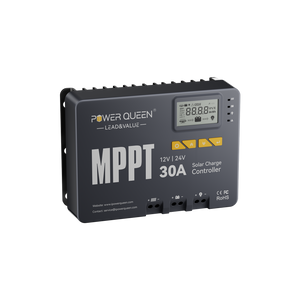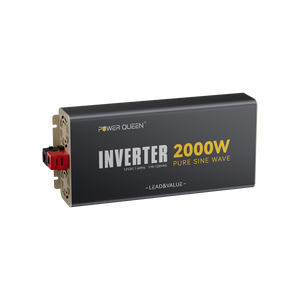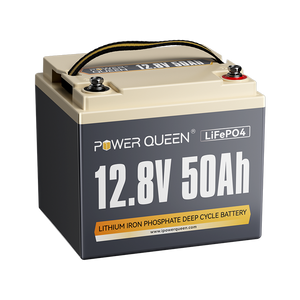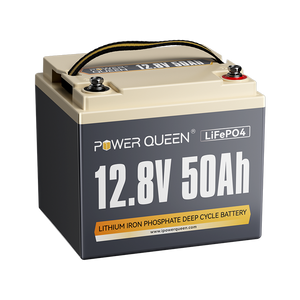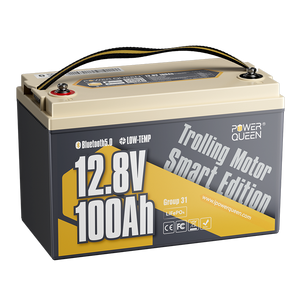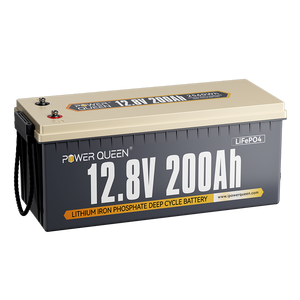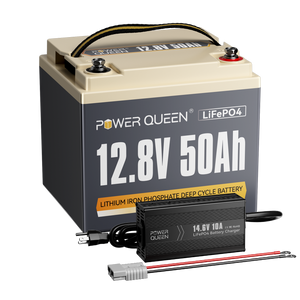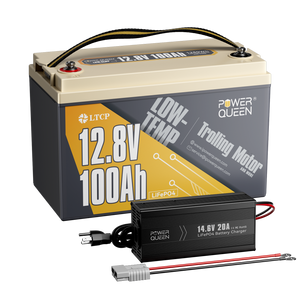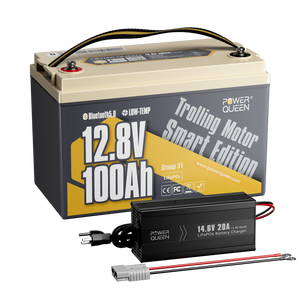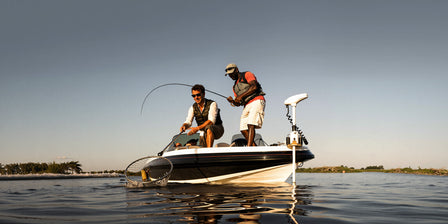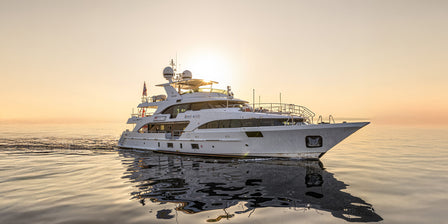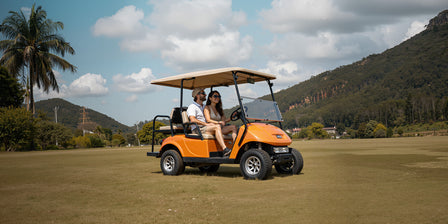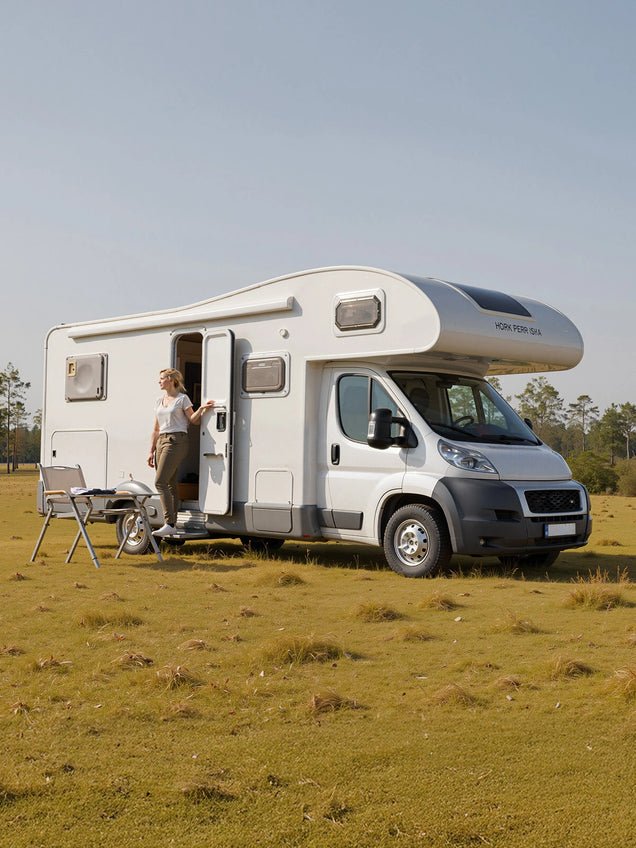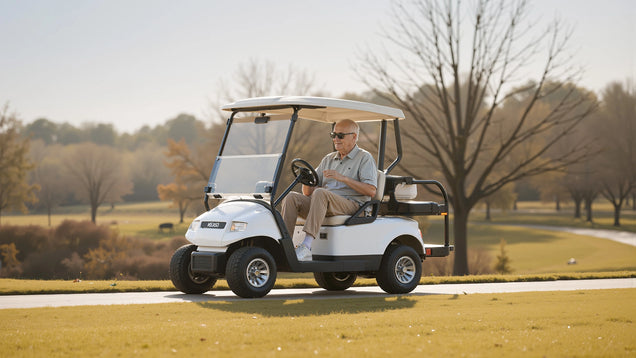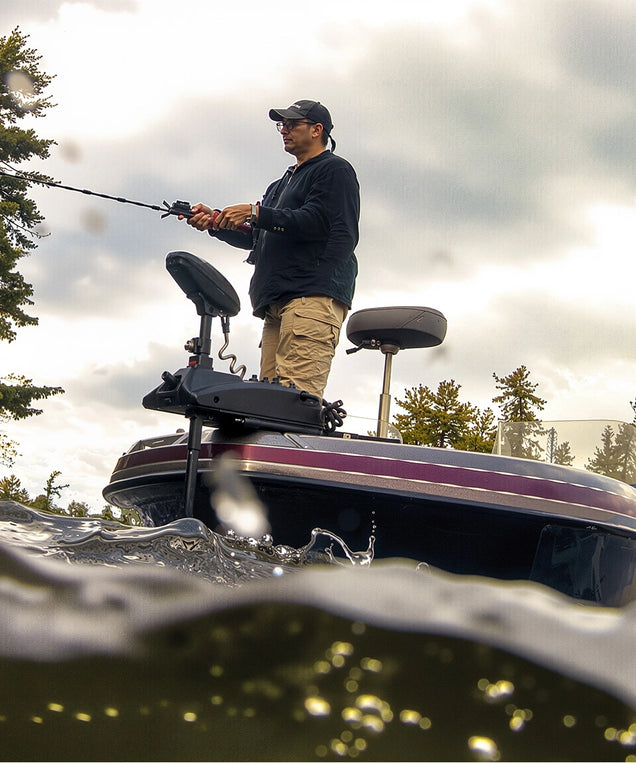How Long Do Trolling Motor Batteries Last & Tips to Extend Their Lifespan
A trolling motor is essential for anglers who want to navigate the water efficiently and quietly. While a trolling motor offers many advantages, its performance is directly impacted by the battery that powers it. Without a reliable battery, your trolling motor may not function properly, negatively affecting your fishing experience. So, how long do trolling motor batteries last? This article explores the lifespan of trolling motor batteries and the factors that influence it.
Table of Content
- Part 1. What Are Trolling Motor Batteries
- Part 2. Marine Starting Batteries vs. Deep Cycle Batteries
- Part 3. Deep Cycle Trolling Motor Battery Type
- Part 4. Factors Affecting Trolling Motor Battery Life
- Part 5. How to Maintain the Trolling Motor Battery
- Part 6. What Battery Specifications to Consider?
- Part 7. Can I Change My Trolling Motor Battery to LiFePO4? What's the Benefits?
- Part 8. Choosing The Right Lithium Battery for Your Trolling Motor
- Part 9. Conclusion
Part 1. What Are Trolling Motor Batteries
Trolling motor batteries are specifically designed to power boat trolling motors, providing electricity for extended periods, especially during slow trolling through fishing areas.
On the other hand, boat starting batteries are built to ignite the engine. Marine batteries are essential for both starting the engine and delivering sufficient power to sustain the motor and the devices connected to the boat.
To make an informed decision about the ideal trolling motor battery for your needs, it's crucial to understand the different types of batteries available.
Part 2. Marine Starting Batteries vs. Deep Cycle Batteries
Marine starting batteries are specifically designed to deliver high bursts of energy to start a boat's engine. They discharge a large amount of power quickly and are then rapidly recharged by the engine's alternator.
In contrast, deep cycle batteries are built to provide sustained power over long periods. These batteries are used to run onboard accessories such as trolling motors, radios, and lights. Deep cycle batteries can be discharged and recharged repeatedly without affecting their performance, making them ideal for extended use.
Related reading: Marine Deep Cycle VS Starting Batteries
Part 3. Deep Cycle Trolling Motor Battery Type
Deep cycle trolling motor batteries are essential for powering electric trolling motors used in fishing boats and other marine applications. The three main types of deep cycle trolling motor batteries are flooded lead-acid, AGM (Absorbent Glass Mat), and lithium-ion, each with its own unique features.
3.1 Flooded Lead-Acid Batteries
- Flooded lead-acid batteries are the most traditional and widely used type of deep cycle batteries.
- They are generally the most cost-effective option initially but require regular maintenance, such as checking and refilling water levels.
- They can release gases during charging, necessitating good ventilation.
- These batteries are quite heavy and cannot be fully discharged, with a discharge rate of around 50%.
- Additionally, their average lifespan is relatively short, typically lasting only 2-3 years.
3.2 AGM Batteries
- AGM (Absorbent Glass Mat) batteries are a type of sealed lead-acid battery that uses a glass mat separator to hold the electrolyte in place.
- They are maintenance-free, as they do not require watering and are sealed, so they do not release gases during charging.
- AGM batteries are more resistant to vibration and shock, making them suitable for marine applications.
- They generally have a longer lifespan and better performance in cold temperatures compared to flooded lead-acid batteries.
- However, they are still heavy and cannot be fully discharged, with a discharge rate of around 50%.
- Their average lifespan is relatively short, typically lasting only 2-3 years.
3.3 Lithium-Ion Batteries
- Lithium-ion batteries are known for their high energy density, meaning they can store more energy in a lighter and smaller package compared to lead-acid batteries.
- They have a longer lifespan and can be discharged more deeply without damaging the battery. For example, Power Queen lithium trolling motor batteries can be discharged 100%, allowing you to completely use the stored energy. The life cycle of Power Queen lithium batteries ranges from 4000 to 15000 cycles, with a service life of up to 10 years.
- They are lightweight and have a high charge/discharge efficiency, providing longer runtimes for trolling motors.
- Although lithium-ion batteries are more expensive upfront, they offer a longer overall lifespan and superior performance, making them a popular choice for high-end trolling motor setups.
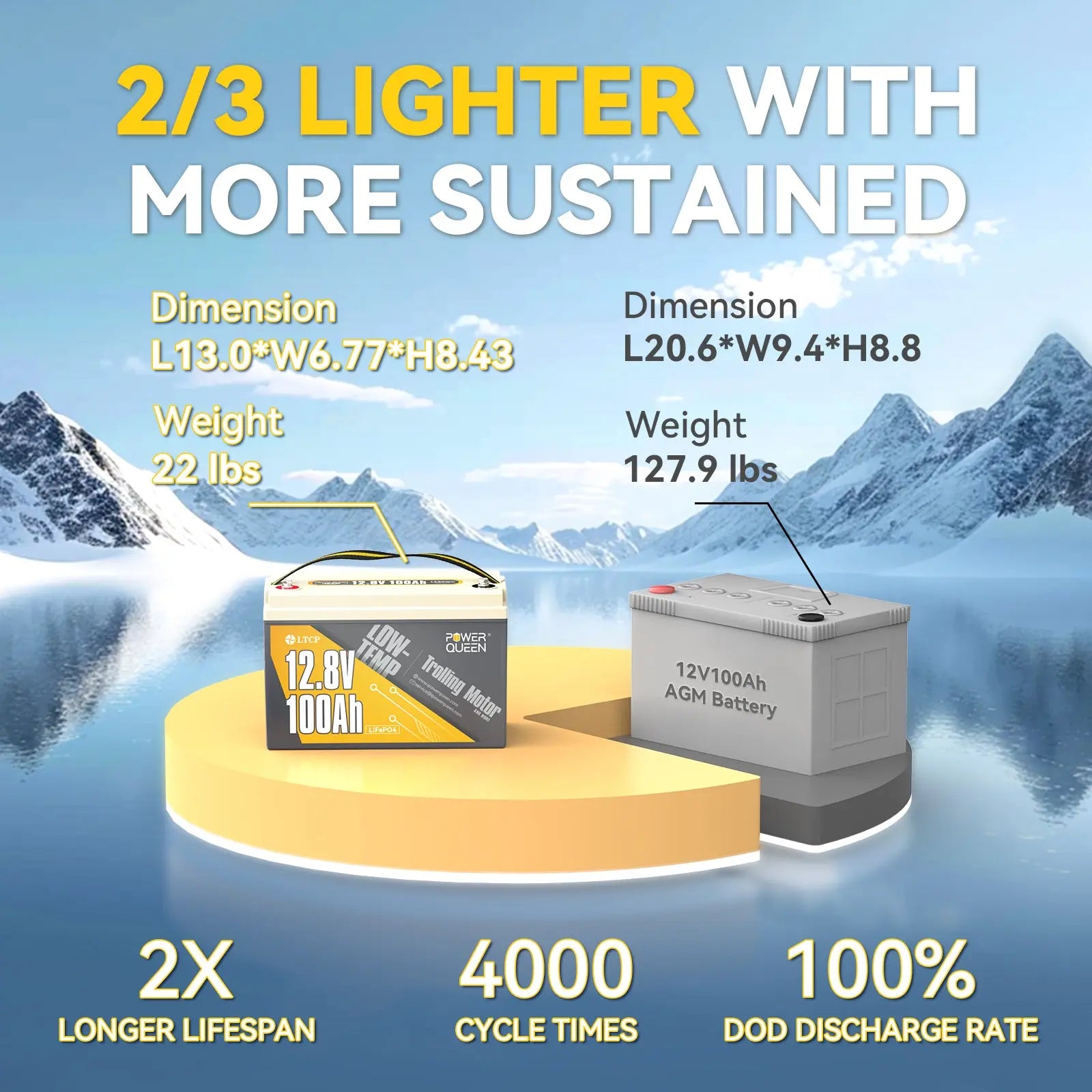
Part 4. Factors Affecting Trolling Motor Battery Life
Here are some factors that can affect the lifespan of a trolling motor battery:
Charge and Discharge Cycles: The number of times you charge and discharge your trolling motor battery impacts its lifespan. Over time, repeated cycling will reduce battery capacity and shorten its life. Power Queen lithium trolling motor batteries, for instance, offer up to 4000-15000 charge and discharge cycles, translating to a lifespan of over 10 years.

Temperature: Extreme temperatures, whether hot or cold, can damage a battery's internal components and reduce its overall lifespan. Always store the battery in a cool, dry place when not in use. Learn more about the optimal temperature range for LiFePO4 batteries.
Depth of Discharge (DOD): The depth of discharge also affects battery lifespan. Consistently discharging a battery too deeply can shorten its life. Lead-acid batteries typically have a DOD of around 50%, whereas lithium batteries can have a DOD of 100%.
Battery Type: The type of battery you use significantly affects its lifespan. Traditional lead-acid batteries generally have a shorter life compared to lithium-ion batteries, such as lithium iron phosphate.
Maintenance: Proper maintenance, such as regular cleaning and checking the water level in lead-acid batteries, can help extend their lifespan.
Usage: The frequency and duration of trolling motor use also impact battery life. Using the trolling motor at high speeds for extended periods will drain the battery faster and shorten its overall lifespan.
Part 5. How to Maintain the Trolling Motor Battery
To ensure your trolling motor batteries deliver prolonged and reliable performance, follow these troubleshooting and maintenance guidelines:
1. Recharge Promptly: Fully recharge your trolling motor battery immediately after use to prevent lead sulfate buildup. This condition, which occurs if the battery is left with less than 12.4 volts, can significantly impact performance and lifespan.
2. Offseason Maintenance: During the offseason, use a trickle charger to maintain the charge of lead-acid batteries, or recharge them monthly. For lithium batteries, use lithium battery chargers and maintain the battery at 40% to 50% of its capacity to keep it in optimal condition. Avoid leaving the battery uncharged for extended periods, as this can reduce performance and longevity.
3. Full Discharge and Recharge: Periodically fully drain and recharge your battery to prevent stratification, where chemicals in the cells become unbalanced and affect performance and lifespan.
4. Cooling Period: Allow the battery to cool down after recharging. Using the battery immediately can cause damage or failure due to the heat generated during the recharge cycle.
5. Equalize Charge: After each recharge, use the equalizing cycle on most battery chargers to balance the battery cells. This process involves an extended, low-current charge to ensure all cells are evenly charged.
6. Maintenance of Wet Cell Batteries: For lead-acid wet cell batteries, check the water levels monthly and top them off with distilled water as needed.
7. Storage and Inspection: Clean the battery and terminals before storing them in a dry, temperate environment during the offseason. Upon removing the battery from storage, thoroughly inspect it for any signs of damage, such as bulging, cracks, frayed cables, or corrosion, which can severely affect performance and safety. For more information, see: How Do You Store LiFePO4 Lithium Batteries.
8. Routine Tests: Conduct routine voltage and specific gravity tests on the electrolyte solution in each cell of lead-acid wet cell batteries to detect issues such as over-watering and inadequate charge.
9. Quality Charger: Invest in a high-quality charger to ensure effective charging and maintain the battery at its full capacity. Suggest reading: How To Charge Trolling Motor Batteries.
General Guidelines
1. Understand Power Requirements: Get familiar with your boat's power needs to better understand how your battery operates.
2. Match Discharge Rate: Ideally, align your battery's discharge rate with the motor's power consumption to optimize both performance and battery lifespan.
3. Operating Conditions: Use the trolling motor in calm waters whenever possible to reduce power consumption and extend battery life.
4. Battery Aging: Monitor your battery's age, capacity, and internal resistance, as aging batteries may show diminished performance and increased resistance. It's advisable to use a battery monitor to keep track of its condition.
5. Steady Usage: Apply a steady and moderate load when using the trolling motor, and adjust speeds gradually to conserve power and reduce strain on the battery.
6. Handle with Care: Handle lead-acid wet cell batteries carefully to prevent damage to the internal plates from vibrations or sudden impacts, which can impair their ability to hold a charge.
Part 6. What Battery Specifications to Consider?
The specifications of a battery can greatly influence your overall experience. With many batteries on the market claiming to be the best, it can be difficult to determine which ones truly excel.
6.1 Amp Hour Rating
Similar to a fuel tank gauge, amp hours indicate how long your battery will last. This measurement represents the amount of charge available in your trolling motor battery.
A higher amp-hour rating means your trolling motor will receive power for a longer period, making this a key specification to consider when choosing a new trolling motor battery.
For reliable performance, it’s generally recommended to select a battery with at least 100 amp hours. However, batteries with higher ratings, such as 125 amp hours, will provide extended operational time. Your choice should be based on your specific needs to determine the most suitable amp-hour capacity for your usage.
6.2 Voltage
Standard deep cycle batteries are typically 12 volts. Before making a final decision, it's important to evaluate your power system to see if a higher voltage is necessary. Some power systems require 24V or even 36V.
Related reading: Trolling Motor Battery System: 12V 24V or 36V
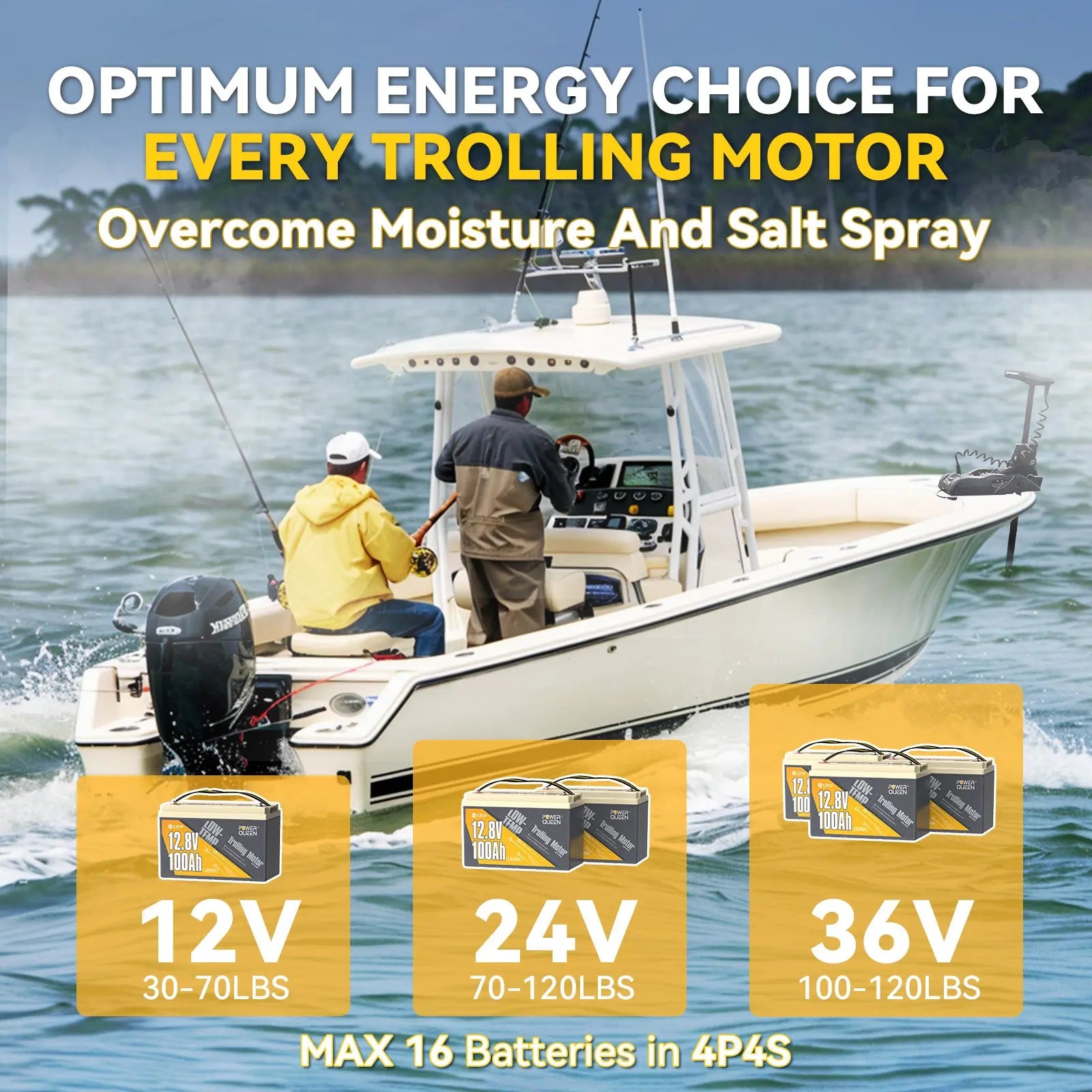
6.3 Useful Tips
When choosing a trolling motor battery, your intended usage is crucial in finding the best fit for your needs. For optimal performance and minimal maintenance, investing in lithium batteries is highly recommended.
Here are some useful tips for maintaining your lithium battery:
- Charge batteries after each use
- Store batteries in a cool, dark place to prevent drainage
- Check for corrosion before use
- Never mix different types of batteries
Part 7. Can I Change My Trolling Motor Battery to LiFePO4? What's the Benefits?
Yes, you can upgrade your trolling motor battery to a Lithium Iron Phosphate (LiFePO4) battery.
LiFePO4 batteries are lighter, offer a longer lifespan, charge more quickly, and have a higher energy density compared to traditional lead-acid batteries. They also require minimal maintenance, provide consistent voltage, and are more environmentally friendly.
Additionally, lithium trolling motor batteries like the Power Queen 12V 100Ah TM come with an advanced Battery Management System (BMS) designed for marine applications. This includes enhanced protection against moisture, dust, and salt spray.
![⚡[Final $189]⚡Power Queen 12V 100Ah Low-Temp Deep Cycle Lithium Battery](//ipowerqueen.com/cdn/shop/files/tm-pd.png?crop=center&format=webp&v=1759823817&width=400)
![⚡[Final $189]⚡Power Queen 12V 100Ah Low-Temp Deep Cycle Lithium Battery](http://ipowerqueen.com/cdn/shop/files/tm-pd.png?crop=center&format=webp&v=1759823817&width=400)
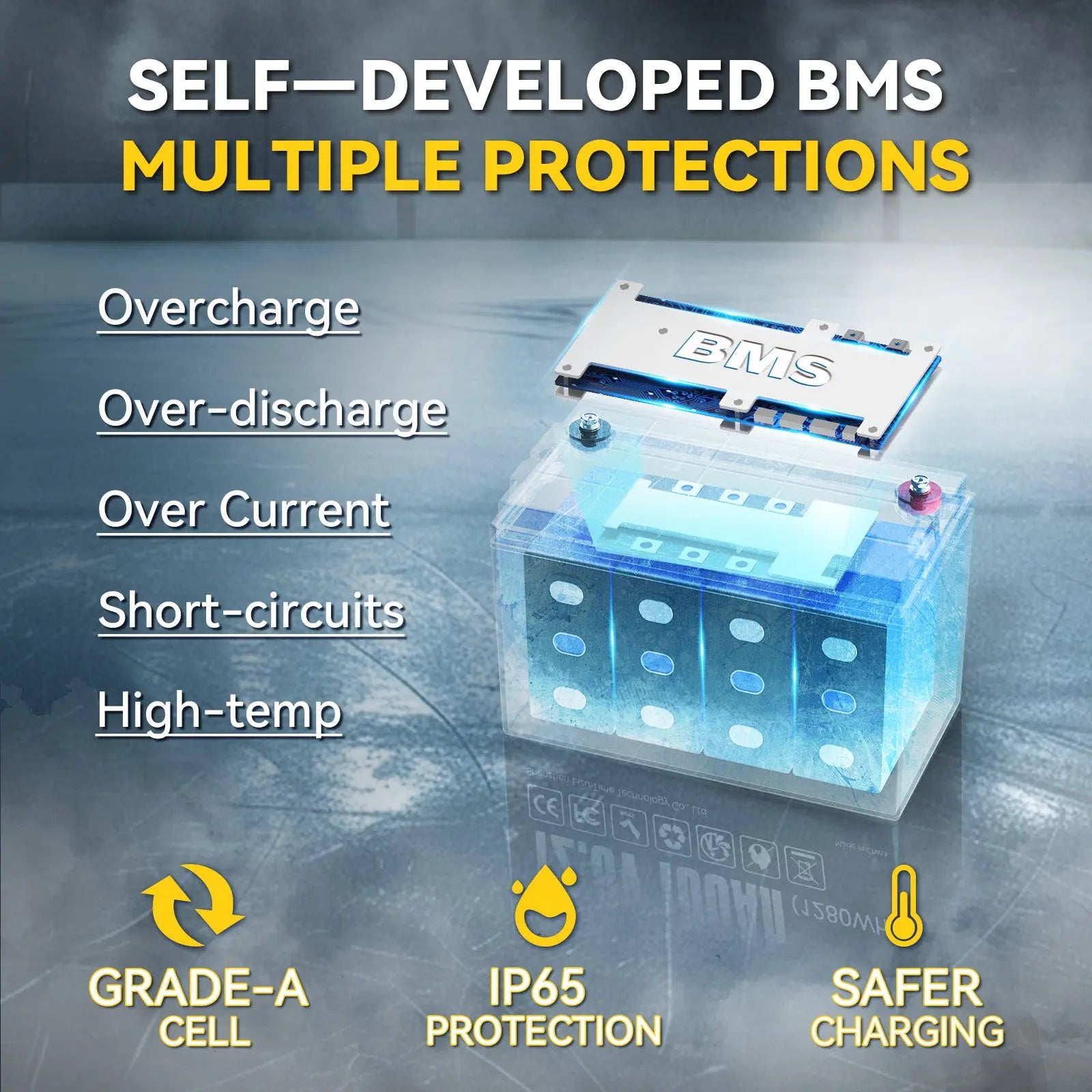
Part 8. Choosing The Right Lithium Battery for Your Trolling Motor
| Voltage of Motor | Motor Thrust | Recommended Max Amp of Batteries | Recommended LiTime LiFePO4 Batteries | Recommended Reasons |
|---|---|---|---|---|
| 12V | 20 ~ 30 lb | 50A | Power Queen 12V 50Ah Lithium Battery | Cost-effective |
| 12V | 30 ~ 70 lb | 100A | Power Queen 12V 100Ah Lithium Battery | Cost-effective, Low-temp, Lighter |
| 24V | 70 ~ 100 lb | 100A | Power Queen 24V 100Ah Lithium Battery | Cost-effective |
| 36V | 100 ~ 120 lb | 100A | 3* Power Queen 12V 100Ah Lithium Battery | 3 batteries in series |
Part 9. Conclusion
By choosing the right battery type, following recommended charging practices, and using the trolling motor under optimal conditions, you can extend the battery's lifespan and improve your fishing experience.
It’s important to adhere to the manufacturer’s maintenance and care guidelines to ensure reliable performance over the years. Alternatively, upgrading to LiFePO4 batteries can further enhance your experience.
